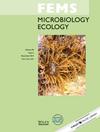Genetic redundancy in the naphthalene-degradation pathway of Cycloclasticus pugetii strain PS-1 enables response to varying substrate concentrations
IF 3.5
3区 生物学
Q2 MICROBIOLOGY
引用次数: 0
Abstract
Polycyclic aromatic hydrocarbon (PAH) contamination in marine environments range from low-diffusive inputs to high loads. The influence of PAH concentration on the expression of functional genes (e.g., those encoding ring-hydroxylating dioxygenases; RHDs), has been overlooked in PAH biodegradation studies. However, understanding marker-gene expression under different PAH loads can help monitor and predict bioremediation efficiency. Here, we followed the expression (via RNA sequencing) of Cycloclasticus pugetii strain PS-1 in cell suspension experiments under different naphthalene (100 and 30 mg L-1) concentrations. We identified genes encoding previously uncharacterized RHD subunits, termed rhdPS1α and rhdPS1β, that were highly transcribed in response to naphthalene-degradation activity. Additionally, we identified six RHD subunit-encoding genes that responded to naphthalene exposure. In contrast, four RHD subunit genes were PAH-independently expressed and three other RHD subunit genes responded to naphthalene starvation. Cycloclasticus spp. could, therefore, use genetic redundancy in key PAH-degradation genes to react to varying PAH loads. This genetic redundancy may restrict the monitoring of environmental hydrocarbon-degradation activity using single-gene expression. For Cycloclasticus pugetii strain PS-1, however, the newly identified rhdPS1α and rhdPS1β genes might be potential target genes to monitor its environmental naphthalene-degradation activity.普氏旋毛虫菌株 PS-1 的萘降解途径中的基因冗余能够应对不同的底物浓度
海洋环境中的多环芳烃(PAH)污染从低扩散输入到高负荷都有。在多环芳烃生物降解研究中,多环芳烃浓度对功能基因(如编码环羟化二氧酶的基因)表达的影响一直被忽视。然而,了解不同 PAH 负荷下标记基因的表达有助于监测和预测生物修复效率。在此,我们(通过 RNA 测序)跟踪了普氏旋孢藻菌株 PS-1 在不同萘(100 和 30 mg L-1)浓度下的细胞悬浮实验中的表达情况。我们发现了编码以前未定性的 RHD 亚基(称为 rhdPS1α 和 rhdPS1β)的基因,这些基因在萘降解活动中的转录量很高。此外,我们还发现六个 RHD 亚基编码基因对萘暴露有反应。相比之下,四个 RHD 亚基基因的表达与 PAH 无关,另外三个 RHD 亚基基因对萘饥饿有反应。因此,Cycloclasticus 可利用关键多环芳烃降解基因的基因冗余对不同的多环芳烃负荷做出反应。这种基因冗余可能会限制利用单基因表达监测环境碳氢化合物降解活性。不过,对于 pugetii Cycloclasticus 菌株 PS-1,新发现的 rhdPS1α 和 rhdPS1β 基因可能是监测其环境萘降解活性的潜在目标基因。
本文章由计算机程序翻译,如有差异,请以英文原文为准。
求助全文
约1分钟内获得全文
求助全文
来源期刊

FEMS microbiology ecology
生物-微生物学
CiteScore
7.50
自引率
2.40%
发文量
132
审稿时长
3 months
期刊介绍:
FEMS Microbiology Ecology aims to ensure efficient publication of high-quality papers that are original and provide a significant contribution to the understanding of microbial ecology. The journal contains Research Articles and MiniReviews on fundamental aspects of the ecology of microorganisms in natural soil, aquatic and atmospheric habitats, including extreme environments, and in artificial or managed environments. Research papers on pure cultures and in the areas of plant pathology and medical, food or veterinary microbiology will be published where they provide valuable generic information on microbial ecology. Papers can deal with culturable and non-culturable forms of any type of microorganism: bacteria, archaea, filamentous fungi, yeasts, protozoa, cyanobacteria, algae or viruses. In addition, the journal will publish Perspectives, Current Opinion and Controversy Articles, Commentaries and Letters to the Editor on topical issues in microbial ecology.
- Application of ecological theory to microbial ecology
- Interactions and signalling between microorganisms and with plants and animals
- Interactions between microorganisms and their physicochemical enviornment
- Microbial aspects of biogeochemical cycles and processes
- Microbial community ecology
- Phylogenetic and functional diversity of microbial communities
- Evolutionary biology of microorganisms
 求助内容:
求助内容: 应助结果提醒方式:
应助结果提醒方式:


